Joseph Cornell's boxes are little universes, each with its own private semantic. Universes whose grammar is one of juxtaposition, like the famous and fortuitous dissection table rendezvous of sewing machine and umbrella that engendered Surrealism.
Today, fishing for a lost button among the random objets that lead a quiet, subterranean life at the bottom of my pen basket, I came up with these evocative items:
Make what you will of eraser, faceless Christ, old chestnut and Audubon bird whistle.
Or of the marble, screw and thimble beside the forty year old nubbin of bread (keep this and you'll never go hungry) I got as a child in some cathedral in Quebec.

The world of these honey locust pods is dark and grave -- forest green going to black. They seem like elders, stiff, severe, spondylitic; they glisten, as if laminated, or coated in brittle ice. Dead already, or very nearly so.

These alder catkins, on the other hand, hang in luminous space, still, serene, balanced. They are gently curved, nubbly, embryonic, promising life and transformation.

The wild cucmber is its own universe -- tendril, flower, leaf, fruit, all magically deployed like a Rube Goldberg machine.

This world -- dusty green dendritic lichen world -- feels both ancient and child- like to me; it's a dense, dissolving scribble; it's veins and smoke; it's submarine. Things float and rise.

These bedstraws, silhouetted against deep, luminous green, remind me of creation itself -- stars being born; tracings in a bubble chamber.
I could look at these images all day. I could lose myself in them. As I lost myself as a child in blue willow landscapes and comic book panels.
The ways of lenses are beyond me. Medically, I embarrass myself around diopters. It took me months to understand how a macro lens sees the world -- what the backgound light will be like, what part of the subject will be infocus. I had a cheat sheet taped to the back of my old camera, an ancient, reliable Minolta 7s I inherited from my in-laws.
And then, of course, there's digital.
Its greedy little eye takes in everything, from nosetip to infinity, the forest, the trees, the bark, the beetle on the bark, the spots on the back of the beetle on the bark. It's got more resolution than our grim little president has resolve. Hairsplitting resolution. Hyper-real, like an Andrew Wyeth painting: hit "100%" and each hair on the kitty makes its claim on the eye.
One can go from a panorama of my study
to the shingles on the neighbors roof
with a few mouseclicks.
The digital eye is democratic, giving equal importance to the kitties asleep on the comforter, the flamingo night light on the bureau, and the athlete's foot spray on the bedside table.
Plummeting down and rising up through resolutions, one feels a little like Alice in a pixilated wonderland --
Croquet, anyone ?
No comments:
Post a Comment